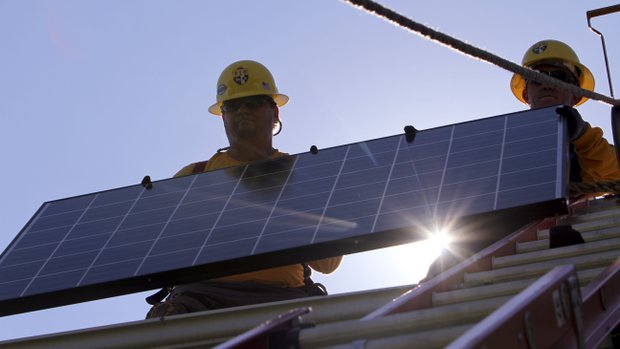forum
library
tutorial
contact

Solar Incentives Reward
West-facing Panels
by Morgan Lee
Union-Tribune, September 12, 2014
|
the film forum library tutorial contact |

|
Solar Incentives Reward
by Morgan Lee
|
 California is encouraging home builders that install rooftop solar energy systems to tilt hose panels westward toward the setting sun.
California is encouraging home builders that install rooftop solar energy systems to tilt hose panels westward toward the setting sun.
The goal is to capture more renewable energy in the waning hours of the day, when electricity demands are often highest, explained David Hochschild, a member of the California Energy Commission who specializes in renewable energy. The goal is to avoid more of the air pollution that comes from gas-fired generators at conventional power plants.
In the northern hemisphere, rooftop panels typically have been oriented toward the south to capture as much sunlight as possible throughout the day.
West-facing panels generate about 20 percent less power overall. But can boost energy production by 50 percent or more between the hours of 2 p.m. and 8 p.m.
"Even though it is less energy on an annual basis, it's more valuable from an air pollution perspective," Hochschild said in an interview on Friday.
The new guidelines increase rebates for west-facing solar energy systems in new home construction by 15 percent, or as much as $500, under a program known as the New Solar Homes Partnership. Solar energy systems added to existing homes are not eligible.
Hochschild said it appears to be the first incentive in the country based specifically on west-facing solar panels.
"There's that opportunity to get it right even before the customer moves into the house," he said.
Many major home builders are offering rooftop solar as standard equipment to help buyers offset utility costs. About 100,000 new homes are expected across California this year.
California's rooftop solar rebates, based on the generating capacity of each solar array, are being phased out gradually as the state closes in on its goal of 3 gigawatts of generating capacity from small-scale systems. The state has surpassed 2 gigawatts. A large nuclear reactor, like those at Diablo Canyon, has a steady 1 gigawatt capacity.
Separately, utilities are contracting with sprawling new solar arrays on remote desert locations to meet mandates for 33 percent renewable energy by 2020. Some of those large solar installations track the sun's daily arc across the sky.
learn more on topics covered in the film
see the video
read the script
learn the songs
discussion forum
